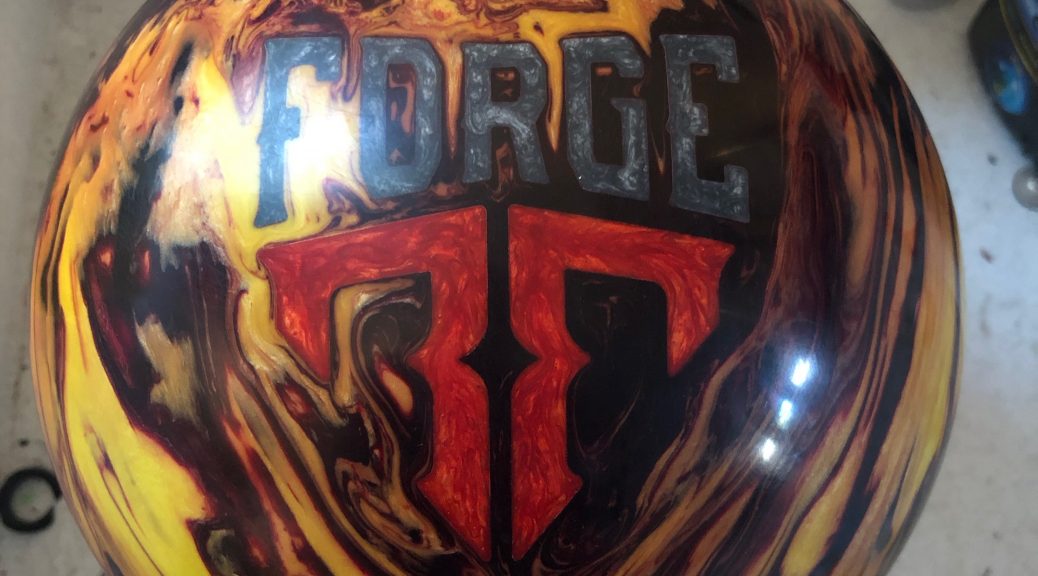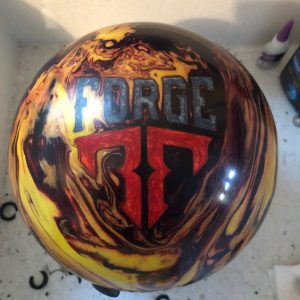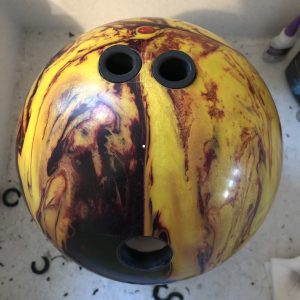The Fire Turns Up The Heat…
First Impressions
Forge Fire looks heavy rolling but angular. We need to study this a bit more to figure out what we have here.
Our Testers:
Tamer Elbaga (Lefty)
Style: Tweener
RPM: 375 rpm
PAP: 5 & 3/8 up
Average Speed: 18.5 mph (at release)
Axis tilt: low
Axis rotation: medium/high
Test Equipment: 14 Pounds
Layout: 65 x 5 x 40
Intent: Medium/long roll with a medium transition at the breakpoint
Sean Jensen (Righty)
Style: Power player
RPM: 475 rpm
PAP: 5 1/2 & 1/4 up
Average Speed: 18.5 mph (at release)
Axis tilt: low
Axis rotation: medium
Test Equipment: 14 Pounds
Layout: 60 x 5 x 45
Intent: Medium/long roll with a medium transition at the breakpoint
Bryan Hoffman (Righty)
Style: Higher Tilt Stroker
RPM: 280 rpm
PAP: 4 1/4 & 1/8 down
Average Speed: 17.5 mph (at release)
Axis tilt: high
Axis rotation: medium
Test Equipment: 14 Pounds
Layout: 65 x 4.5 x 35
Intent: Medium roll with a slow transition at the breakpoint
Thanks to Jeff Smith and Pure It Bowling for drilling our equipment.
Buy the Motiv Forge Fire at PureItBowling.com.
Thanks to Limerick Bowl in Limerick, PA.
“Keep in mind that coverstock accounts for 70% of ball reaction, but the core creates the dynamic shape of the reaction. Your driller will alter the shape to suit your game.”
Test Pattern:
THS: 40ft, 23ml
Sport: Rt 66: 45ft, 23.3 ml, 3.67:1 ratio
Value
B-
The Forge Fire is priced on the high end. It’s utility will be tempered to times where you need heavy roll but big angle.
Specs
The Forge Fire uses the Detonator™ (symmetric) core inside the Infusion™ Hybrid Reactive coverstock.
15 pound = RG of 2.47, diff of .055
14 pound = RG of 2.49, diff of .054
Coverstock finish: 4000 grit LSS
Overall
THS: B-
This is interesting and what I first saw I wasn’t quite sure what to make of. Well the most obvious feature of the Forge Fire is angularity. There is no shortage of that. The second is that it does have a bit of that lumbering heavy early rolling feel. So what does combining these characteristics do for this ball? I’m not 100% certain yet. For house, it’s nice to get angularity so you can increase your entry angles. What I saw was probably an exacerbated angularity. Combine an angular ball with high axis rotation and you get a lot of 8 pins… Nevertheless, once I cut the axis rotation a touch, I can take full advantage of that downlane move for really good carry. The Fire really reminds me of the United Revolt. Heavy rolling ball that still has aggressive axis transition. And with that, I think it will lead to some limitations in that the situation has to be right to use the Forge Fire. The heavy roll adds control on tougher shots. The angularity helps on house shots. So early days it’s hard to tell if there will be lots of situations where you need both. I’m only spending time talking about it because these are both prominent characteristics of the Forge Fire. This combination worked well in the United Revolt in some unique situations where it was really the only thing that worked. Compared to the original Forge, you can see very similar overall strength but whereas the Fire seems almost hook set, the Forge has a smooth rounded booming move that I believe makes it a little more versatile.
Sean was next. Higher rev rate and less axis rotation. What’s interesting is while the Forge seemed to really go sideways with my higher axis rotation, it set and rolled earlier with much less angularity for Sean with the lower axis rotation. So the hook set characteristic is still prominent but the ball rolled very forward for Sean. Sean was playing fairly direct, well over an arrow straighter than me. To take advantage of that heavy roll he cut down his angles significantly. It’s a little difficult to tell why it was tricky to use but this is part of why I have to take it all in to understand and rate the ball. The other thing is that realistically, this is a strong ball and likely a bit too strong for this medium house shot. Obviously patterns will play different from day to day so having something when it plays a little slicker is always a good idea.
Bryan absolutely loves his Forge so he had high hopes for the Fire. Straight out of the gate, he was able to easily find the pocket and see the delta where the fire turns a bit quicker in it’s hook phase. Bryan had a good look taking advantage of the angularity. What’s interesting is what happened as the lanes transitioned. As the fronts started to go, the ball didn’t hook early. It stopped hooking. So it was clearly burning up. It just lost axis quickly and rolled out. I did not see that issue in my testing. In fact I kind of wished it would stop a little sooner. So he started getting flat hits and lost entry angle. Compared to the Forge, it was also a little soft from the same spot. He moved right and was able to see that much smoother Forge motion to hit hard.
Sport Shot
We tested on the 45ft Kegel Rt 66 pattern. I expected this ball to be right at home here. A longer pattern that requires a bit of a stronger move downlane if you’re playing the fall back. I would say it didn’t quite hit the bullseye for me. Roll looked good with good midlane control. To be fair I did carry decently but it was mostly scatter hits. It didn’t really drive off the spot the way the Choice did for example. It’s just way smoother. I did experiment with a shot 13 to 7 and was pretty surprised to see how good the shot looked from there. Dead flush. The ball’s certainly got potential.
For James you can see a similar reaction. The ball is a bit too smooth and doesn’t quite get off the spot the way you’d like on a shot that’s playing a tight breakpoint. Still, it was reasonable, if not quite first line.
Bryan tried to find that tight line fade to the pocket as well. It was a little tricky as he was playing straighter than James and I and the ball did start up in the midlane if he was too direct. I think the Paradox Red could be a good sport shot ball but perhaps not quite matched perfectly to this longer pattern.
Final Thoughts
With the Forge Fire, Motiv offered a ball that can be angular in heavier conditions. We had 3 testers who each saw a different ball reaction. The one absolute is the low RG core got into a roll early for everyone. How much downlane motion seemed to vary by bowler. It definitely differentiates itself from everything else in the lineup and offers a look no other Motiv ball currently offers. So there you have it, the Motiv Forge Fire.



